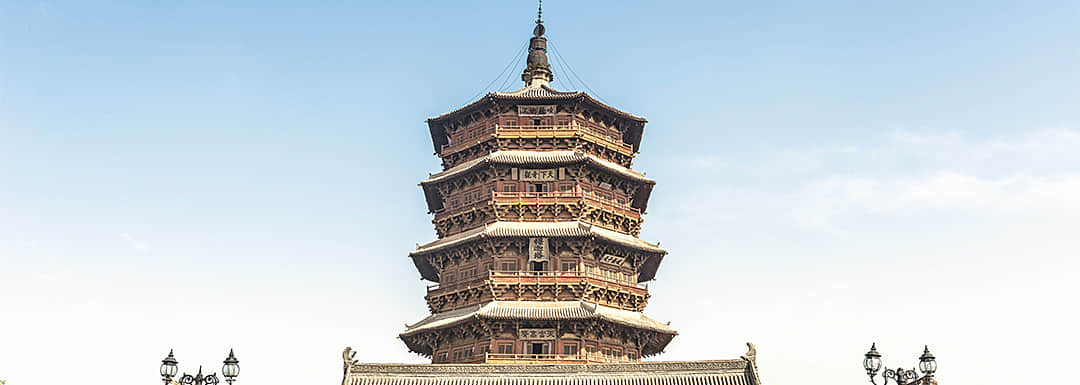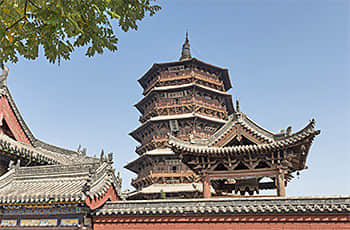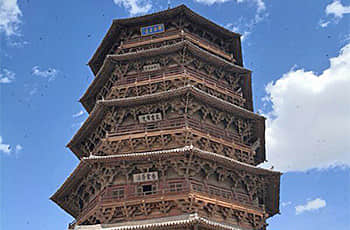Wooden Pagoda at Ying County

This pagoda is also called Sakyamuni Pagoda of Fogong Temple. Located in the Buddha Temple in northwest Ying County, Shuozhou, Shanxi Province, it was built in 1056 CE, and is the highest and oldest existing wooden pagoda in China. It is a national key cultural relic that is under protection and a national AAAA-level scene (five As means the top scenes). Some people rank it with Eiffel Tower and Leaning Tower of Pisa. In 2016, Sakyamta was recognized by the Guinness Book of World Records as the tallest wooden tower in the world.
- Chinese Name: 应县木塔 yìng xiàn mù tǎ
- Suggest time: 2 hours
- Ticket: RMB 60 per person
- Address: Ying County, Shuozhou City, Shanxi Province
- Open hours: 07:00-18:00
- The best time to visit: from April to October
- How to get there: Take Bus No. 28, 38 or 59 and get off at Jiulongbi (Nine-Dragon Wall) Station. Walk for another 310 meters to reach the street.
Highlights of the Wooden Pagoda at Ying County 

The Wooden Pagoda is located between the gate and the main hall along the north-south axis of the temple. The layout sets the pagoda before the hall. The building is constructed on a four-meter-high platform with a height of 67.31 meters and a base diameter of 30.27 meters. It is a flat octagonal shape. Two doors are set separately on the north and the south side of the building. Wooden banisters are set on each balcony for the second floor and above. It has wooden stairs so that visitors can reach the top. There are four doors on each floor of the second to fifth floors with wooden partitions. Buddha statues are provided on each floor. The first floor has the statue of Sakyamuni, who is 11 meters tall. There are six Buddha statue drawings on the wall of the inner groove. Vajra, heavenly kings, and disciples are also painted on the two side walls of door openings. On the altar of the second floor, there are statues for one Buddha, two bodhisattvas and two retinues.
Buddha Tooth Relic
Two Buddha tooth Sariras are enshrined in the pagoda. With Seven Treasuries, they are kept in two silver containers. They are verified as the remains of Sakyamuni. After the annihilation of the Buddha, a total of seven Buddha tooth relics were left. The two Buddha tooth relics found in this temple were once stolen by Jieji Rakshas as recorded by Nirvana Sutra, South Version.
Eight Mallas Below Lotus Base 

There is a tall statue sitting on a lotus base opposite the gate of the wooden tower on the ground floor. And eight Mallas are carrying the base with vivid facial expressions. They are guardian gods for eight directions. When the Buddha was giving lectures around the world, they gathered together and broke into the secular world. Their descent to the world shocked the mortal world.
Horizontal engraved boards and Buddhist scriptures
There are boards engraved by Emperors Zhu Di and Zhu Houzhao, separately saying “Top Craftsmanship” (Jun Ji Shen Gong) and “Wonder of the Country” (Tian Xia Qi Guan).
54 boards and couplets from the Ming, and Qing dynasties and the Republic of China are kept in the tower. A number of cultural antiques are also reserved there. The colored wood engraving blocks help restore the history of Chinese printing. There are many volumes of scriptures in the collection too. Some are manuscripts while others were printed in the Liao Dynasty. Some scriptures are over 30 meters long.
Travel Tips: For the protection of the old relics, visitors are only allowed to visit the first floor of the Pagoda and not allowed to climb all the way up.
Drop us a line and we'll connect you with the top China expert in no time!